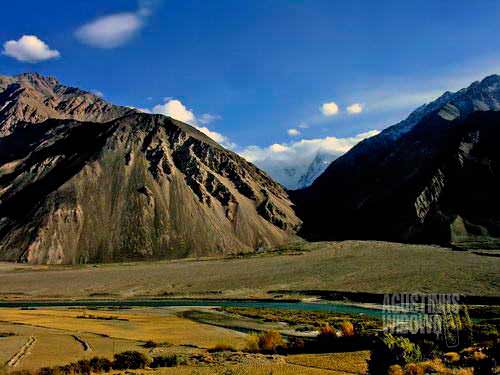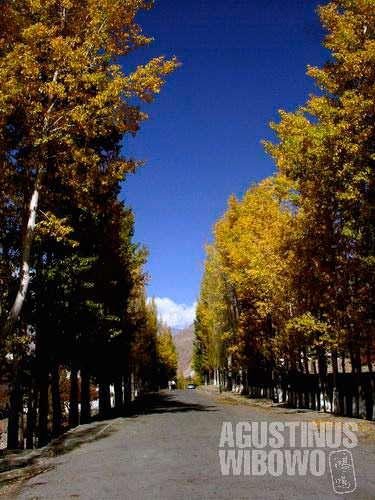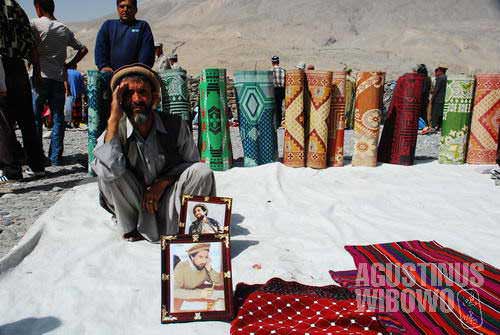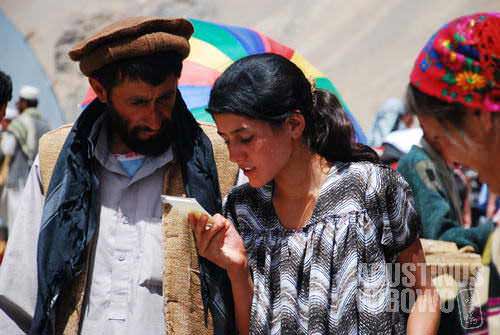Ishkashim – Peeping into Afghanistan

Afghanistan, seen from Tajikistan
It is just separated by a river. But the live over there is a world away.
Khorog and Ishkashim are connected by a stretch of a 106 km long asphalted road. It is a 3 hour journey with public jeep, but cost as much as 20 Somoni ($6). Despite of lack of money that people earn, everything in Tajikistan is very expensive as the country produces almost nothing remarkable but water and electricity.
The road to Ishkashim as along the Panj river, with Afghanistan Badakhshan province at the other side. The river itself had not strong stream (as the temperature is already quite low at this moment) and was not wide at all. Afghanistan is just less than 20 m from here, but the life there is a world away.
While we are traversing smooth road of Tajikistan with a jeep, the road over there is complete dirt road and you may observe Afghan travellers wandering the world on donkeys. When women passengers in our jeep in Tajikistan side sit aside the other male passengers, talk and sing freely during the journey, an Afghan woman completely covered by blue veil, wears long loose trousers, and passes the other direction on a donkey behind her husband. In this side of the river, electric poles queue in line, as they were ridiculing the other side of the river which has nothing but yellowing grass.
Afghanistan is visible from here, as Tajikistan is visible from there. An old woman, whose house is just next to the river in that side, was drying animal thongs on roof of her house, waved her hands and smiled happily when seeing our jeeps passing in this side of the river. It is just a 20 meter wide river, but separated both sides at least the distance from earth to the clouds. It is roughly visible, but only imagination is permitted to pass through the distance, land on the limit of fantasy about the live on the other world. The imagination lingering in people’s mind is about the life just across the river, with all of its regrets and gratefulness of fate and destiny.
For the Tajikistan people, aside about the ugly visible appearance of Afghanistan from this river side, not much is known about the life on that world across the river. Muhammad, a fellow passenger, told me, “In Soviet time, they (the Russians) told us to be aware from the Afghans. They said that the Afghans were dangerous people and they would cross the river and come here. We were not allowed to look at that side. We were not allowed to point our finger there, as the Afghans would come here.” There was a certain effort from the Communist leader to propagate, to put the concept that the Moscow government wanted the people to swallow, about the badness of the Afghans.
The border between Afghanistan and Tajikistan was drawn not more than 150 years ago, and it used the Panj River (Amu River) as natural border. Sounds like natural, the Soviet and British actually sliced the world with a sharp axe, which then divided many villages and relatives by completely impassable invisible wall.
The invisible wall between Tajikistan and Afghanistan, the Panj River, means a lot to me. I have been to both sides of the river. Three months ago I was in the Ishkashim of Afghanistan, looking at Tajikistan and heard what people there imagined about their secular brothers. Now I am in Tajikistan side, looking at Afghanistan and hearing what the Tajik citizens telling about their warring neighbour. Looking at Afghanistan was a pain in my heart, seeing the dirt, undeveloped villages which I just struggled around in past few months. It brought me all of the memory of gruelling around the country, which the people in this Tajikistan side of the river regarded as underdeveloped country locked in history.
Actually it was not the Afghans who then crossed the border. When there was Civil War in Tajikistan, it was people from here who crossed the river to Afghanistan,” said Muhammad, “and by the time, the Afghan might ridicule us, ‘see we had twenty years of wars and we don’t go to your country, but you just had a short civil war you came to our country.’
The civil war which then isolated GBAO of Tajikistan from outside world had brought so much sorrow the people in this area. Feared by huge wave of refugees, the CIS soldiers controlled the river border in Wakhan area very, very tightly, nobody was allowed to get close to the river. Thus there were many refugees succeeded made their way as far as Pakistan and China.
Now is still the month of Ramazan, the Muslim holy month of fasting. But nobody in our jeep was fasting. The car stopped in a chaikhana (restaurant) and all passengers went for lunch. The driver even drank vodka together with some other friends. Vodka was introduced by the Russians, and most of the Afghans never touched it, especially in the month of Ramazan during fasting time. I know the people on that river side of Afghanistan are also Ismaili Muslims, but I wonder whether most people there also fast 9 days in Ramazan and drink vodka during the days like people in this side.

The quiet road of Ishkashim, Tajikistan
Sharif, a doctor from Tajikistan Ishkashim, had been to the Afghan Ishkashim. As a doctor he, with some nurses, went there as medical team. They needed neither passport nor visa, as they had special duty. What Sharif thought about Ishkashim of Afghanistan?
“Life here is better than there. Over there the people are not educated. It is also difficult,” Sharif then told me in detail, “for woman patients they only allowed female nurses. When I was there, there were many women patients but not enough female doctors. I wanted to help, but they didn’t allow me. ‘No, it’s not possible,’ said them. The doctors there are also not experienced or educated. Even they make mistakes in writing prescriptions. Medicine is also not widely available.”
Sharif saw Afghan Ishkashim from his spectacles as a doctor.
“So there is nothing that Afghanistan is better than Tajikistan?”
“Nothing.”
“But I have heard that people there saying Afghans had nothing but money, Tajikistan had everything but no money.”
“Yes. For that you are right. Here people don’t have money. A big director here may earn 200 Somoni per month, not even a hundred dollar.”
In fact many people in Tajikistan earn less than 50 Somoni per month while price of everything is crushing the poor souls.
Sharif earns 80 Somoni to 100 Somoni per month, but when he worked in Afghanistan he got 50 Somoni DAILY, with not much work to do. What most interested him, that in the fundamentalist country, when he had to check a female patient. If the patient had a toothache, the patient will be put behind a curtain, where there was a small hole. The patient would open her mouth behind the curtain exactly on the hole and Sharif had to check her from the other side of the curtain, so he only saw the teeth of the patient and not any other part of her body. The same when a patient had a pain in hands or legs.

Afghan trader in the international bazaar of Ishkashim. I came here later in 2008, from the Afghan side of Ishkashim.
Ishkashim also suffered a lot from the high price of the goods in Tajikistan since the oil price rise. Sugar cost 1 dollar per kg here, and rice was 3 Somoni/kg. Thanks to isolation of GBAO. But the new bridge with Afghanistan opened nearby, with an access to weekly international market on a neutral island on the river, has brought many good things. At first I wondered what people really could trade here. At this side of the river, there is no production at all, and so was Ishkashim on that side of the river. Later I found that the traders from Tajikistan sold motor spare parts and iron material and they imported agricultural products from Afghanistan. Muhammad’s uncle even sold vodka to the Afghans, and it was a very good business. “It cost 7 Somoni per bottle but I can sell at 15 Somoni. They buy a lot.” Despite the fact that it is an Islamic country, Afghanistan doesn’t strictly implement ban on alcohol.
Corruption scandals also overshadowed Tajikistan. The bridge itself cost US$35,000 from the national budget, said a woman resident of Ishkashim, but actually the foundation of the bridge was already laid down by the Soviet. So the Tajikistan government was actually only painted and decorated it, and it should not cost U$S 35,000 for that job. The bridge is located few kilometres from Ishkashim, and didn’t look grand at all. For these two weeks the Afghan bazaar is closed, a pity as I wanted to observe the atmosphere of the international trading. This was due to the visit of the President Imamali Rakhmanov together with the Ismaili spiritual leader, the Aga Khan. One may also question why the president chose to come together with the Ismaili leader while in his policy he neglected much about development in the Ismaili dominated GBAO province. But everything about politics is very sensitive now, as the Tajik election is coming in next month.
Muhammad, whose nickname is Alisher, invited me to his house in Ishkashim. The city of Tajik Ishkashim is a small town with a main road with tidy houses along the road, and a small bazaar. The city is cool and quiet, with friendly neighbourhood where almost everybody knows everybody else. The houses are walled. The main material is stones, as that is what this area rich of. Alisher is an MSDSP staff from Dushanbe, and from him I learnt a lot about the programs of the NGO.
Alisher’s house is a Pamiri traditional house. Actually there are two parts of his house, one part is the normal Tajik style house where the family cooks and has dinner. The other part is the Pamiri house, which has characteristics which is shared by the houses in Chapursan (Pakistan) and Wakhan (Afghanistan). The Pamiri houses date back since the pre-Islamic time, when the area was influenced by Zoroastrianism. The ventilation four edged hole, where the natural illumination from the sun brighten the room comes, symbolized the four elements of the world: fire, air, earth, and water. The five pillars in the main room symbolize Muhammad, Ali, Fatima, Hassan and Hussain (the two brothers, sons of Imam Ali, are the two pillars joined together leading to the entrance door, and located at the same side as the pillar of Fatima). The connection between the pillars to the Islamic Prophet’s family actually started just after the area converted to Islam. The history of Pamiri houses (khuneuni chid) dated far before Islam.
Compared to the same style of houses in Northern Areas of Pakistan and Wakhan Corridor of Afghanistan, the Tajikistan Pamiri houses had been touched much by modernity. The central pit is not used anymore as cooking place. In every room there is noticeable photo of Aga Khan, the spiritual leader. The walls are painted, covered with traditional carpets, posters,and family photos. There is often also a set of table and chair, which is not common at all for the same ethnics who had the fate in the neighbouring Islamic Republics. The modern bulbs enlightened the nights – Tajikistan is blessed by exportable energy. When a guest is coming, the host will prepare immediately a carpet to sit between the pillars of Ali and Muhammad, as symbol of welcoming.

An Afghan man and a Tajik woman, in Ishkashim international bazaar
Modernity is the thing makes the Tajikistan side of the Ismaili people different from their brothers and sisters in Afghanistan and Pakistan side. The Russians had put much effort in boasting education in this area and fostered modernization. The people wore modern dresses already, with occasionally traditional caps or simple headscarves. “Tajikistan is a mixture between three cultures: Russian, Islamic, and Western,” said Alisher quoting His Highness speech during the difficult time of Tajikistan, “so all international aid has to consider these elements when providing aid in Tajikistan, to make it more meaningful for the people. The Russian culture is represented by women equity. The Islamic culture is the moral conduct. And the western culture is science and technology.” These mixtures make the Ismaili people at this side of the river very distinct from their counterparts in Afghanistan and Pakistan. The people in Tajikistan side are also proud of their high education, thanks to the Soviet programs.
“When they started to divide us,” said Alisher, “people at time were thinking, how our life would be if we just 20 meters away from here, just at that side of the river. People thought that under the British, it would be a better life.” Afghanistan was considered as part of the British colony, or at least, British puppet. I showed him some pictures at the other side of the river, from Ishkashim and Wakhan of Afghanistan. I noticed expression of surprise on his face. He never imagined that the life over there would be like the photos saying. He only saw Afghanistan from this side of river, just the overall texture of Afghanistan. He knew that it was underdeveloped, but never sees that close like in my photos. He now saw the interior of the Pamiri houses in Afghan side, made by mud and darkened by the oil. He also saw the women covered in veil, and the fact that they were forced to wear burka, known in Tajikistan as ‘paranji’. He saw the darkness of life over there, without any bulb to lighten the nights little bit. Also about the uneducated looking villagers and children taking care of the animals the whole day. “Now I am happy with my fate,” said him. It was a country separated by a river, but history has made that country locked in time, preserving their life like what it was a century ago.
At night we went out a little bit. Ishkashim of Afghanistan is little bit higher, on top of a plain hill at the other side. It was very bright at night, looked like Hong Kong seen from the ocean. “See, they are getting better now,” said Alisher. I looked at my watch. It was 9 p.m Tajikistan time, or 8:30 p.m. I bet it was the time for the Indian serial on Tolo TV, that infamous serial about mother in law, which I imagined attracted the attention of all beard men in the village.
In this side of the river, I also developed my imagination and fantasy about Afghanistan, the country just a river away in distance but a century away in time.

Hi, salam kenal ya? Interesting skl tulisan2 ttg travellingnya. Knapa gak dibukukan aja? Saya nge link ya…